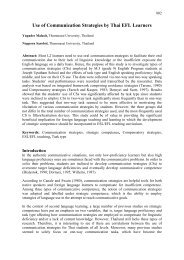The Effects of Semantic Mapping on Vocabulary Memorizing
The Effects of Semantic Mapping on Vocabulary Memorizing
The Effects of Semantic Mapping on Vocabulary Memorizing
You also want an ePaper? Increase the reach of your titles
YUMPU automatically turns print PDFs into web optimized ePapers that Google loves.
C. Anh ấy lấy những c<strong>on</strong> tem ra và cất lại những ph<strong>on</strong>g bì.<br />
3. He was in orbit around the Earth at a speed <str<strong>on</strong>g>of</str<strong>on</strong>g> more than 17,000 miles per hour.<br />
A. Anh ta đã ở trên vòng xoay bay vòng quanh Trái Đất với vận tốc hơn<br />
17,000 dặm trên giờ.<br />
B. Anh ta đã ở trên đường bay bay vòng quanh Trái Đất với vận tốc hơn<br />
17,000 dặm trên giờ.<br />
C. Anh ta đã ở trên quĩ đạo bay vòng quanh Trái Đất với vận tốc hơn 17,000<br />
dặm trên giờ.<br />
Piloting the tests<br />
Piloting testing can help avoid costly time-c<strong>on</strong>suming problems during the data collecti<strong>on</strong><br />
procedures (Gass & Mackey, 2000). In order to be used in this study, the pre-test and the posttest<br />
<strong>on</strong> vocabulary knowledge were piloted to ensure the validity <str<strong>on</strong>g>of</str<strong>on</strong>g> this instrument. Forty-two<br />
students who were <str<strong>on</strong>g>of</str<strong>on</strong>g> the similar background and level <str<strong>on</strong>g>of</str<strong>on</strong>g> English pr<str<strong>on</strong>g>of</str<strong>on</strong>g>iciency as those in the<br />
<str<strong>on</strong>g>of</str<strong>on</strong>g>ficial study got involved in the pilot test. <str<strong>on</strong>g>The</str<strong>on</strong>g> results from the piloted test showed that with<br />
clear initial instructi<strong>on</strong>s and examples given in the tests the pre-test and the post-test <strong>on</strong><br />
vocabulary knowledge used in this study were valid.<br />
Scoring the tests<br />
To score the pre-test and the post-test, the same scoring system was used. Each correct answer<br />
was given <strong>on</strong>e mark. <str<strong>on</strong>g>The</str<strong>on</strong>g>re were no minus marks for providing incorrect answers. <str<strong>on</strong>g>The</str<strong>on</strong>g>refore, the<br />
maximum scores <str<strong>on</strong>g>of</str<strong>on</strong>g> each test could be 80 for 80 correct items. <str<strong>on</strong>g>The</str<strong>on</strong>g> researcher and her colleague<br />
independently scored the students’ tests to make sure that the test results were reliable and<br />
objective. This original score was then subjected to SPSS for data analysis.<br />
5.2 Questi<strong>on</strong>naire <strong>on</strong> the students’ percepti<strong>on</strong>s towards semantic mapping<br />
<str<strong>on</strong>g>The</str<strong>on</strong>g> questi<strong>on</strong>naire aimed at measuring the students’ percepti<strong>on</strong>s towards semantic mapping<br />
technique before and after the research. <str<strong>on</strong>g>The</str<strong>on</strong>g> questi<strong>on</strong>naire could help the researcher collect more<br />
detailed data <strong>on</strong> the students’ percepti<strong>on</strong>s and interests that could not be noted by the tests. In<br />
additi<strong>on</strong>, the questi<strong>on</strong>naire provided an<strong>on</strong>ymity which helped provide reliable large amounts <str<strong>on</strong>g>of</str<strong>on</strong>g><br />
resp<strong>on</strong>ses. Actually, Wils<strong>on</strong> and McLean (1994, cited in Cohen, Mani<strong>on</strong> and Morris<strong>on</strong>, 2000)<br />
suggested that “the questi<strong>on</strong>naire is a widely used and useful instrument to collect survey<br />
informati<strong>on</strong> research”.<br />
Adapting the questi<strong>on</strong>naire<br />
<str<strong>on</strong>g>The</str<strong>on</strong>g> questi<strong>on</strong>naire was adapted from Huynh’s (2009) 24-item questi<strong>on</strong>naire <strong>on</strong> learners’ attitudes<br />
towards the use <str<strong>on</strong>g>of</str<strong>on</strong>g> mind mapping in learning and teaching vocabulary. In terms <str<strong>on</strong>g>of</str<strong>on</strong>g> questi<strong>on</strong>naire<br />
adaptati<strong>on</strong>, 13 items remained and the order <str<strong>on</strong>g>of</str<strong>on</strong>g> these items was changed. Besides, 9 more items<br />
were added to meet the purpose <str<strong>on</strong>g>of</str<strong>on</strong>g> the study.<br />
<str<strong>on</strong>g>The</str<strong>on</strong>g> questi<strong>on</strong>naire is comprised <str<strong>on</strong>g>of</str<strong>on</strong>g> 22 items in total. Each item includes a statement about<br />
students’ attitudes towards using the semantic mapping technique in memorizing vocabulary <strong>on</strong><br />
the Likert Scale (str<strong>on</strong>gly disagree, disagree, neutral, agree, and str<strong>on</strong>gly agree). All the items<br />
are categorized into three cluster including (1) students’ interest in memorizing vocabulary with<br />
642






